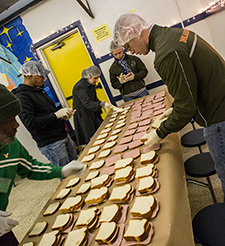Office of Research & Development |
 |
Office of Research & Development |
 |

VA Research Currents archive
December 31, 2014

U.S. Marines prepare sandwiches during a volunteer event at a homeless shelter in New Orleans in 2013. A new VA study suggests conducting rapid HIV screening in shelters is a cost-effective way to reach Veterans who are HIV-positive and need care. (Photo by Lance Cpl. Mackenzie Schlueter)
Rapid HIV testing could have a dramatic effect on treating Veterans who are both homeless and HIV-positive, according to a VA study appearing in the January 2015 issue of the American Journal of Public Health.
While Veterans only make up around 11 percent of the U.S. population, they continue to be overrepresented among the U.S. homeless population. On any given night, Veterans make up some 26 percent of the nation's homeless population of nearly 610,000, putting them at a higher risk for a myriad of other conditions —among them, HIV.
With a rate of infection at least three times higher than that of the U.S. population, the homeless aren't just more likely to be infected; they're less likely to be diagnosed in a timely fashion. As a result, they suffer higher mortality rates.
"The link between homelessness and HIV is widely established. Even when we can get them tested for HIV, nearly a third don't receive their results," says Dr. Henry Anaya, a research scientist at the VA Greater Los Angeles Healthcare System.
According to the Centers for Disease Control and Prevention, people who are unaware that they are HIV-positive are three to four times more likely to infect others.
"Given the risk, targeting homeless Veterans for HIV testing is imperative," says Anaya.
The problem is that traditional HIV testing involves several appointments. One to take the test, another several days later to receive the results, and, if necessary, counseling and linkage to care if the individual is found positive. With a highly transient population such as homeless individuals, that is neither practical nor feasible, says Anaya.
Anaya and a team of researchers set out to implement an HIV rapid testing and linkage-to-care program complete with onsite counselors to essentially create a pipeline between homeless shelters and VA care. The pilot took place in Los Angeles County, the unofficial "homeless capital" of America.
The pilot included the VA researchers who developed the study, alongside counselors from the Los Angeles County Office of Aids Programs and Policy as well as the City of Los Angeles AIDS coordinators' office. "We believe this type of multi-agency effort offers advantages. County or city agencies can implement HIV testing—however, without VA involvement, linking Veterans to care could be time-consuming and costly. [At the same time], VA is prohibited from testing non-Veterans. Cooperation is the key to making a program like this work," says Anaya.
Three shelters were selected for the program. Flyers and loudspeaker notifications were used to let residents know about the HIV testing.
Over the course of 26 months, counselors made 189 separate visits to the shelters and administered 817 tests. As it turned out, 37 of the 817 people tested were Veterans, and none of them was found positive. However, overall, seven of the 817 tests came back positive, and five of these individuals were linked to care. One refused care. The other did not return.
Each test cost, on average, just under $50. The cost per positive result—that is, per new HIV diagnosis—was $5,714.
Anaya and his coauthors say this is "in the range of reasonable cost," citing costs of HIV screening programs in other settings.
A 2013 review by the Centers for Disease Control and Prevention shows that the cost per new HIV diagnosis ranged from $1,900 to $10,000 in studies of screening programs in health-care settings. In studies of programs run by various community-based organizations, the cost per new HIV diagnosis ranged from $10,334 to $20,413. Health economists take into account both the costs and outcomes of interventions—including gains in the quality and quantity of extra years lived—when determining cost-effectiveness.
Anaya's team also found that the costs of their screening program went down as the study progressed. "Our cost analysis confirmed the program was most expensive at inception, declining over time," they wrote.
Reflecting on the outcomes of his group's study, Anaya asserts that while an almost one-percent prevalence rate may not seem high, the potential impact of these cases is quite significant—and that screening is therefore well worth the effort and expense.
"When you consider the long-term result of not being treated for HIV, coupled with the risk of these people infecting others, it's more than worth it," says Anaya. "It's cost-effective. It's targeted, and it could have a massive effect on HIV rates in a very vulnerable population.